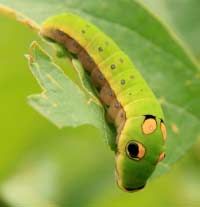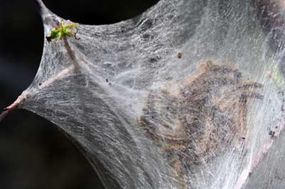Quck answer
Caterpillars are the larval stage of butterflies and moths. They have a soft, cylindrical body with three pairs of legs in front of the body and several pairs of prolegs at the rear. Caterpillars feed on plant leaves and use their strong mandibles to chew and break down the leaves. They have a unique digestive system that allows them to break down tough plant fibers and extract the necessary nutrients. Caterpillars also have a respiratory system that consists of tiny holes on the sides of their body called spiracles. These spiracles allow air to enter and exit the caterpillar’s body, providing oxygen for respiration. As they grow, caterpillars shed their skin several times in a process called molting. Finally, when they reach their full size, they form a pupa and undergo metamorphosis into a butterfly or moth.
Wild Animals
The Role of Silk and the Behavior of Caterpillars: Shelters and Pathways

The primary food source of caterpillars makes them vulnerable to predators. To protect themselves, many species resort to camouflage. For instance, swallowtail caterpillars look like bird droppings in their early instars. When they grow too large, they molt and reveal green bodies with eyespots that make them look like snakes. Some caterpillars use color to blend in with their surroundings or display warning colors to predators.
However, caterpillars employ more than color and shape to evade predators. Some feed from the undersides of leaves to avoid being spotted by airborne birds. Others nibble on multiple leaves in small amounts or eat only partway through the leaf’s structure to reduce visible damage. Besides, some species even consume their shed skin and launch their waste away from their leaf shelter to prevent predators from tracking them.
Silk is an essential tool used by caterpillars to build their shelters or move around the tree they inhabit. Some species use their silk as a rope and harness like a rock climber to climb back up to the leaf if they fall. Gregarious caterpillars, which live in large groups, rely on silk for their survival. They construct large tents, bivouacs, or other shelters using their silk and neighboring plant material. They also lay trails of silk from the tent to the food and build a network of trellises to navigate the tree where they live.
The silk is also crucial to the transformation of caterpillars into butterflies. Most species use their silk during this process. We will explore this aspect in detail shortly.

Gregarious tent caterpillars rest inside their silken nest.
В© iStockphoto/Kris Hollingsworth
The Pros and Cons of Group Living for Caterpillars
Gregarious caterpillars face both advantages and disadvantages when living in large groups. The benefits include an increased likelihood of finding food, building nests, and surviving. However, living in such close proximity with numerous siblings also raises the risk of diseases spreading throughout the population. Additionally, while following a well-established trail can make it easier for a caterpillar to locate food, it also means having to compete with siblings for sustenance. There is also a debate around whether group living makes caterpillars more or less vulnerable to predation.
FAQ
1. What is a caterpillar?
A caterpillar is the larval stage of a butterfly or moth. It is a soft-bodied, worm-like creature that hatches from an egg and spends most of its life eating and growing.
2. How do caterpillars move?
Caterpillars move using a series of muscular contractions along their body called “prolegs.” These prolegs are equipped with tiny hooks that help the caterpillar grip onto surfaces as it moves.
3. What do caterpillars eat?
Caterpillars are herbivores and typically feed on leaves, flowers, and stems of plants. Some species are more selective in their diet, while others will eat a wide variety of plant species.
4. How do caterpillars protect themselves?
Caterpillars have a variety of defense mechanisms to protect themselves from predators. Some species have spines or hairs that can be irritating or toxic, while others use camouflage to blend in with their environment.
5. How do caterpillars transform into butterflies or moths?
Caterpillars undergo a process of metamorphosis, which transforms them into adult butterflies or moths. They form a chrysalis or cocoon, where they undergo a series of physical changes until they emerge as an adult.
6. How long do caterpillars live?
The lifespan of a caterpillar varies depending on the species. Some species only live for a few weeks, while others can live for several months.
7. How do caterpillars breathe?
Caterpillars breathe through small openings on the sides of their bodies called spiracles. These spiracles allow oxygen to enter and carbon dioxide to exit the caterpillar’s body.
8. Are all caterpillars harmful?
No, not all caterpillars are harmful. While some species have toxic spines or hairs, many species are harmless and even beneficial to their ecosystems as a food source for other animals.





Leave a Reply